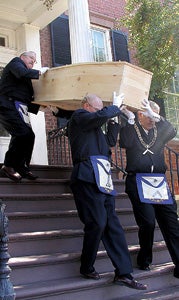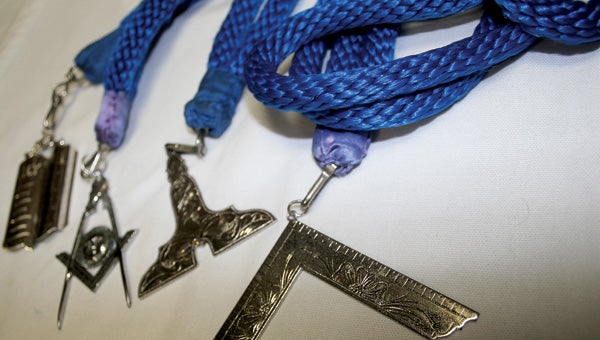Mystery and tradition
Published 12:47 am Monday, November 19, 2012
It’s an organization whose secrecy is legendary, the stuff from which books are written, movies produced and conspiracy theories made.
It’s a brotherhood whose ties extend backward for centuries and with its roots in the temple to Jehovah that King Solomon built nearly 3,000 years ago. And even though many of the signs and symbols are ancient, Freemasonry endures all around the world. In Suffolk, the organization traces back more than 220 years, with Masons meeting at the same site since 1847 and in the same building since 1911.
It’s the building at the corner, appropriately, of North Main and Freemason streets in the downtown area. The one with the blacked-out windows. It’s that secrecy thing again.

A Masonic funeral is an occasion for ceremony and traditions and gives Freemasons the opportunity to serve the community and the family of their deceased brother. Masons attend ceremonies attired conservatively and wearing the symbols of their order. Members of Suffolk Lodge No. 30 gave the community a look at their funeral traditions when Riddick's Folly held a recreation of the funeral of Judge Nathaniel Riddick in 2008.
But not everything Freemasons do is a secret, and Suffolk’s Tom Lord, Tiler (a sort of Sergeant at Arms) for Suffolk Lodge No. 30, admitted a visitor to the facility recently and revealed a bit about the local arm of the international organization, along with its history and purpose.
“I want to bring Freemasonry out of the closet,” he said, “try to explain who we are and what we are as Masons.”
Behind the secret handshakes, the secret signs, the secret passwords and all the rest of the mystery, Freemasonry is about some very basic concepts, he said. “Fellowship, brotherhood and working for the good of the community.”
Members get together to share meals at the lodge, to conduct lodge business, to learn the things they have to know to advance in the organization and to discuss how they can serve the needs of the brotherhood and the community.
“Freemasonry is a brotherhood of men who believe in God and who, through their association with Freemasonry, become better men,” he said. “Everybody is our brother, whether a Mason or not. A Mason becomes more tolerant, and attuned to what is right in this world.”
The organization’s meetings, open only to Masons, are held in the second floor of the Masonic lodge, which was built from plans and specifications drawn up by Charles Fine Taylor, a vice president of Lummis and Co. in the early 20th century. Taylor also served as Senior Warden and then Worshipful Master of the Lodge from 1909 through 1911, the period when the Masonic temple was being planned and built.
It was not the first building on the property. The original structure on the site served as a Masonic Lodge and as one of the first schools in Suffolk, Lord said. During the Civil War occupation of Suffolk, the 11th Indiana Cavalry used it as a lodge for its own Masonic meetings, and Union soldiers used it as a hospital. Lord says there is also evidence that one of three signal towers located in what is now Suffolk was erected on the property.
When the U.S. soldiers decamped from Suffolk, he said, they took many “souvenirs” from the lodge, including its founding charter, a ceremonial sword and “jewels” worn by members to denote their rank within the organization.
“It took us 46 years to get our charter back,” Lord said, noting that Masons from a lodge in Rhode Island helped return it in 1909. “At the age of the lodge, to have those — that’s important to our heritage.”
Freemasons have been integral to the history of Suffolk. A roll of Worshipful Masters, the lodge’s annually elected leaders, includes names that are familiar to any Suffolkian: Riddick, Prentis, Pruden, Parker, Eley, Woodward, Barton, Causey, Norfleet, Quimby, Cutchins, Harrell, Duke and many others. Some of the city’s founding fathers and some of its most influential citizens have been Freemasons in Lodge No. 30, according to the bicentennial history.
The same things are true at the national level and internationally. George Washington was a Freemason and is said to have laid the cornerstone of the Capital building in full Masonic dress. A Freemason designed the Statue of Liberty.
Masonic traditions — and secrets — have been handed down from one generation of Masons to the next, from one Grand Lodge in England, where the order is thought to have started in the 16th century; to the U.S., where it was brought in 1719; to the Grand Lodge in Virginia, which chartered the Sinai Chapter, Lodge No. 30, in 1790; to the smaller lodges that spawned from the mother lodge in Suffolk.
Through it all, the traditions endure. In the words of a booklet printed in 2002 for the benefit of men petitioning to join the organization, “… understand that you are not merely joining a Lodge, but that you are becoming a part of a worldwide brotherhood of Freemasons, and that the sun never sets upon its Lodges.”







